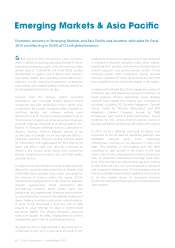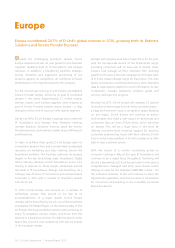D-Link 2010 Annual Report Download - page 17
Download and view the complete annual report
Please find page 17 of the 2010 D-Link annual report below. You can navigate through the pages in the report by either clicking on the pages listed below, or by using the keyword search tool below to find specific information within the annual report.
Long-standing relationships with reliable vendors and
manufacturers have contributed to D-Link’s reputation as
a dependable partner for service providers. Internet
Service Providers (ISPs) view D-Link as a "one stop shop"
with comprehensive oerings, including everything from
consumer-level ADSL routers found in the home to
enterprise-level management switches which provide
advanced infrastructures for ISPs.
Service providers face many challenges in the current
competitive environment, especially since average
revenue per user has begun to drop while operating
expenses have begun to increase. The demand for data
trac has grown as a result of the increased use of
cloud-dependent mobile devices and the large adoption
rate of bandwidth-heavy applications, such as video
streaming. Additionally, Telcos and Internet Service
Providers have experienced growing conict as they
determine how to appropriately share bandwidth loading.
One of the main concerns from both Telcos and their
subscribers as the rate of data trac increases has been
bandwidth allocation. To address this problem, D-Link’s
Smart QoS technology allows content to be classied and
prioritized according to the preference of the Telco or its
subscribers to ensure that enough bandwidth is allocated
to preferred applications. By using device signatures,
home devices can be automatically identied and
prioritized according to a pre-dened hierarchy for
bandwidth allocation. The use of OSGi as a service
platform allows service providers to easily add new
applications or services for subscribers.
As subscribers demand more services, such as on-site and
online technical support, D-Link has relieved ISPs of some
of the burden with its Remote Support System (RSS) for
home networking management. D-Link’s Network helper
application lets home users easily diagnose and x
Internet connection problems via a step-by-step graphical
user interface. Similarly, D-Link’s Network Map allows users
to manage and monitor home devices via a friendly user
interface to let users adjust settings such as parental
controls and home networking topology.
With the growing number of mobile handsets and smart
phones, service providers have needed to address the
obstacle of 3G trac loading. D-Link provided two solutions
to address this issue with Femtocell access points and Wi-Fi
hot spots. D-Link’s years of experience with access
connectivity and wireless technology have placed the
company in a solid position to provide Femtocell solutions
to service providers. Centralized management via D-Link’s
access controller helps to reduce setup time for Wi-Fi hot
spots serving multiple devices.
To enhance its mobile solutions business, D-Link produced
several 3G dongles that attracted service providers with
their simplicity and performance. D-Link’s presence in
consumer networking and the digital home leaves the
company prepared to deliver the next generation of mobile
networking devices.
The increasing demand for more bandwidth looks to be a
trend that will continue for quite some time due to the
high-speed connection required for modern applications.
Products oering higher throughput will be in demand,
including GPONs, DOCSIS3.0 routers/gateways, VDSL,
ADSL2+ IADs, and media gateways. In the mobile market,
3GPP Long Term Evolution (LTE) has emerged to also relieve
the deciency in bandwidth, ultimately creating a transition
in more stable ecosystems such as North America and
Europe. Considering the current landscape, D-Link seeks to
expand its global reach with an emphasis on emerging
markets and a renewed determination for developed
nations.
D-Link has successfully established a competitive mobile product line to complement its
ourishing broadband oerings as it accommodates the evolving needs of the Telco
market.
Service Provider Solutions
16 | D-Link Corporation | Annual Report 2010




















